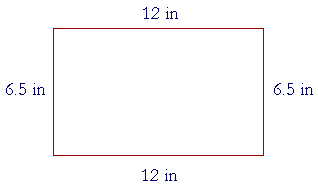|
Lesson 5 ADDING WHOLE NUMBERS
|
||||||||||||||||||||||||||||||||||||||||||||||||||||||||||||||||||||||||||||||||
|
||||||||||||||||||||||||||||||||||||||||||||||||||||||||||||||||||||||||||||||||
On adding the ones column, we get 9. But on adding the tens column, we get 16. Now, 16 tens = 10 tens + 6 tens (Lesson 3.) Write 6, and regroup 10 tens onto the hundreds column -- because 10 tens are equal to 1 hundred. Therefore when we add the hundreds, we have 1 + 6 + 4 + 5 + 8 = 24 Again, 24 hundreds = 20 hundreds + 4 hundreds Write 4, and regroup 20 hundreds onto the thousands column -- because 20 hundreds are equal to 2 thousands. (Lesson 3, Example 3c.) When we add the thousands, then, we get 2 + 4 + 8 + 5 + 3 = 22. The sum of those numbers is 22,469.
"5 + 2 is 7." Write 7. "4 + 8 is 12." Write 2 -- carry 1 mentally. "5 + 9 is 14, plus 1 is 15." Write 5 -- carry 1 mentally. "9 + 8 is 17, plus 1 is 18." Write 18. |
||||||||||||||||||||||||||||||||||||||||||||||||||||||||||||||||||||||||||||||||
|
||||||||||||||||||||||||||||||||||||||||||||||||||||||||||||||||||||||||||||||||
|
Example 1. Write in a column and add: 4,785 + 9 + 2.307 Solution.. The ones are shown: 4,785 + 9 + 2.307 (Lesson 2, Question 5.) Therefore, align as follows:
Example 2. Write in a column and add: .58 + 5.8 + 58 Solution. Here are the ones: _.58 + 5.8 + 58 As for .58, the ones are at the first place to the left of the decimal point. Align as follows:
When there are decimal points, align them. The decimal point in the answer will fall in the same place. (But this is true only in addition and subtraction, not in multiplication. Lesson 9, Question 3.) As for a whole number such as 58, to help with alignment we may imagine a decimal point after the 8. 58 = 58. Whole numbers, however, are normally written without a decimal point because the decimal point means "and" -- here come the fractions! Example 3. .5 + .5 + .5 Choose the correct answer: a) 15 b) .15 c) 1.5 d) .015 Answer. c) 1.5 For, if we aligned them and wrote .5 as 0.5 --
-- we would see that the 1 (of 15 tenths) carries over into the next column. The point is: In addition and subtraction, the answer Example 4. .007 + .003 + .004 Answer. .014 The numbers being added have three decimal places. Therefore the answer also will have three decimal places. Example 5. Perimeters. The perimeter of a plane (flat) figure is its boundary.
This figure is a rectangle, which is a four-sided figure in which all the angles are right angles. In a rectangle, the opposite sides are equal. Therefore the perimeter of that rectangle is:
Example 6. Add:
Technique. Do not break this up into separate pieces. Add each entire column, starting on the right. To add the first column on the right, let your eye go down that column and say -- do not write -- each partial sum. (See Lesson 4, Question 2.) Say
Write 6, carry 2. To add the middle column, say
Write 1, carry 2. To add the last column, say
Write 25. The decimal point in the answer is aligned with the decimal points above. (This is true only in addition and subtraction, not in multiplication. Lesson 9.) We may write the decimal point in the answer when we come to it; that is, upon adding the middle column. Please "turn" the page and do some Problems. or Continue on to the next Lesson. Introduction | Home | Table of Contents www.proyectosalonhogar.com |
||||||||||||||||||||||||||||||||||||||||||||||||||||||||||||||||||||||||||||||||

